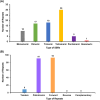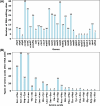Characterization and comparative analysis of the complete mitochondrial genome of Phlomoides rotata, a traditional Tibetan medicinal plant
- PMID: 40770612
- PMCID: PMC12326683
- DOI: 10.1186/s12864-025-11871-9
Characterization and comparative analysis of the complete mitochondrial genome of Phlomoides rotata, a traditional Tibetan medicinal plant
Abstract
Background: Phlomoides rotata, an endemic Tibetan medicinal plant adapted to extreme alpine environments, faces conservation challenges due to habitat degradation and overharvesting. Despite its ecological and medicinal importance, its mitochondrial genome remains uncharacterized, limiting insights into its evolutionary adaptations and genomic architecture.
Results: We present the initial de novo assembly and annotation of the P. rotata mitochondrial genome, a circular molecule with a GC content of 45.06% and a length of 377,312 bp. A total of 32 protein-coding genes (PCGs), three ribosomal RNA (rRNA) genes, and 12 transfer RNA (tRNA) genes were identified through genome annotation. These genes include multicopy genes (trnM-CAU, matR). Analysis of codon usage bias indicated a preference for A/U ending synonymous codons, aligning with trends observed in other angiosperms. RNA editing research revealed 445 C-to-U transitions, predominantly at the second codon position, with nonsynonymous alterations (71%) surpassing synonymous changes, indicating potential functional adaptive roles. Repetitive sequence analysis uncovered 81 simple sequence repeats (SSRs) and a large palindromic repeat (13,075 bp), linked to genomic rearrangements. Homologous alignments identified 12 chloroplast-derived fragments in the mitogenome, including intact tRNA and rpl23 genes, evidencing interorganellar gene transfer. Phylogenetic analysis using 27 conserved PCGs positioned P. rotata within a well-supported Lamiales clade, closely related to Leonurus japonicus, corroborating its taxonomic placement and providing a framework for evolutionary studies.
Conclusions: The P. rotata mitogenome exhibits structural complexity and adaptive features, including codon bias, RNA editing, and repetitive sequences, underscoring its role in high-altitude adaptation. These findings provide critical genomic resources for conservation, breeding, and understanding the molecular mechanisms of organellar evolution in extreme environments.
Keywords: Phlomoides rotata; Adaptation evolution; Mitochondrial genome; Phylogenetics; Qinghai-Tibet plateau.
© 2025. The Author(s).
Conflict of interest statement
Declarations. Ethics approval and consent to participate: Not applicable. Consent for publication: Not applicable. Competing interests: The authors declare no competing interests.
Figures







Similar articles
-
Decoding the complete mitochondrial genome of Hydrangea chinensis maxim.: insights into genomic recombination, gene transfer, and RNA editing dynamics.BMC Plant Biol. 2025 Aug 16;25(1):1078. doi: 10.1186/s12870-025-07119-z. BMC Plant Biol. 2025. PMID: 40817245 Free PMC article.
-
Assembly and comparative analysis of the complete mitochondrial genome of Cardiocrinum giganteum: a primitive Liliaceae group with significant scientific research value.BMC Genomics. 2025 Jul 1;26(1):602. doi: 10.1186/s12864-025-11817-1. BMC Genomics. 2025. PMID: 40597596 Free PMC article.
-
Unraveling the mitochondrial genome of the medicinal Chinese motherwort (Leonurus japonicus, Lamiaceae): structural dynamics, organelle-to-nuclear gene transfer, and evolutionary implications.Front Plant Sci. 2025 Jun 3;16:1546449. doi: 10.3389/fpls.2025.1546449. eCollection 2025. Front Plant Sci. 2025. PMID: 40530293 Free PMC article.
-
Assembly and characterization of the first mitochondrial genome of Phyllanthaceae: a case study of the ornamental aquatic plant Phyllanthus fluitans.Genetica. 2025 Jul 16;153(1):25. doi: 10.1007/s10709-025-00241-8. Genetica. 2025. PMID: 40668455
-
Complete sequencing of the mitochondrial genome of tea plant Camellia sinensis cv. 'Baihaozao': multichromosomal structure, phylogenetic relationships, and adaptive evolutionary analysis.Front Plant Sci. 2025 Jun 13;16:1604404. doi: 10.3389/fpls.2025.1604404. eCollection 2025. Front Plant Sci. 2025. PMID: 40584852 Free PMC article.
References
-
- Sciences, ECotFoCCAo. Flora of China. Volume 65. Beijing: Science; 1977.
-
- Mathiesen C, Scheen A-C, Lindqvist C. Phylogeny and biogeography of the lamioid genus Phlomis (Lamiaceae). Kew Bull. 2011;66:83–99.
-
- Li H, Hedge I, Raven P, Wu Z. Lamiophlomis Kudo. Flora China. 1994;17:156.
Publication types
MeSH terms
Substances
Grants and funding
- 2021-GSP-B019/High-level graduate research project, Xizang University
- 31760127/National Natural Science Foundation of China
- 00060906-01/first-class discipline construction project in ecology
- XZ202402ZY0023/the Science and Technology Program of Xizang Autonomous Region
- XZ202303ZY0002G/Science and Technology Department of Tibet
LinkOut - more resources
Full Text Sources
Miscellaneous

